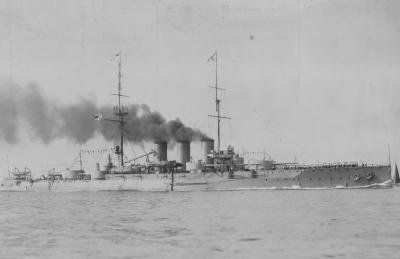Georgios Averof (Greek: / ) is a modified Pisa-class armored cruiser built in Italy for the Royal Hellenic Navy in the first decade of the 20th century. The ship served as the Greek flagship during most of the first half of the century. Although popularly known as a battleship () in Greek, she is in fact an armored cruiser ( ), the only ship of this type still in existence.The ship was initially ordered by the Italian Regia Marina, but budgetary constraints led Italy to offer it for sale to international customers. With the bequest of the wealthy benefactor George Averoff as down payment, Greece acquired the ship in 1909. Launched in 1910, Averof arrived in Greece in September 1911. The most modern warship in the Aegean at the time, she served as the flagship of admiral Pavlos Kountouriotis in the First Balkan War, and played a major role in the establishment of Greek predominance over the Ottoman Navy and the incorporation of many Aegean islands to Greece.
The ship continued to serve in World War I, the Greco-Turkish War of 19191922, and the interwar period, receiving a modernization in France in 1925 to 1927. Following the German invasion of Greece in April 1941, Averof participated in the exodus of the Greek fleet to Egypt. Hopelessly obsolete and prone to mechanical breakdowns, she nevertheless spent the next three years as a convoy escort and guard ship in the Indian Ocean and at the Suez Canal. In October 1944, she carried the Greek government in exile back to liberated Athens, after the withdrawal of the German army.
In 1952, she was decommissioned, before being moved to Poros, where she was berthed from 1956 to 1983. From 1984 until today, she has been reinstated on active duty as a museum ship in the Naval Tradition Park in Faliro, Athens. After maintenance in late 2017, she achieved seaworthiness state once again, allowing the ship to sail (towed) accompanied by Greek frigate Kountouriotis (F-462) (/ ) to Thessaloniki Greece where she received more than 130,000 visitors over her 53-day stay.
The armored cruiser was a type of warship of the late 19th and early 20th centuries. It was designed like other types of cruisers to operate as a long-range, independent warship, capable of defeating any ship apart from a battleship and fast enough to outrun any battleship it encountered.
For many decades, naval technology had not advanced far enough for designers to produce a cruiser which combined an armored belt with the long range and high speed required to fulfill its mission. For this reason, beginning in the 1880s and 1890s, many navies preferred to build protected cruisers, which only relied on a light armored deck to protect the vital parts of the ship. However, by the late 1880s, the development of modern rapid-fire breech-loading cannon and high-explosive shells made the reintroduction of side armor a necessity. The invention of face-hardened armor in the mid-1890s offered effective protection with less weight than previously.
Varying in size, the armored cruiser was distinguished from other types of cruiser by its belt armor—thick iron (or later steel) plating on much of the hull to protect the ship from shellfire much like that on battleships. The first armored cruiser, the Imperial Russian Navy's General-Admiral, was launched in 1873 and combined sail and steam propulsion. By the 1890s, cruisers had abandoned sail and took on a modern appearance.
In 1908, the armored cruiser was supplanted by the battlecruiser, which, with armament equivalent to that of a dreadnought battleship and speed equivalent to that of a cruiser, was faster and more powerful than an armored cruiser. At around the same time, the term "light cruiser" came into use for small cruisers with armored belts. Although they were now considered second-rate ships, armored cruisers were widely used in World War I. Most surviving armored cruisers from this conflict were scrapped under the terms of the Washington Naval Treaty of 1922, which imposed limits on warships and defined a cruiser as a ship of 10,000 tons or less carrying guns of 8-inch caliber or less—rather smaller than many of the large armored cruisers. A handful survived in one form or another until World War II. Only one, the Greek Navy's Georgios Averof, has survived to the modern day as a museum ship.

1911Sep, 1
The armored cruiser Georgios Averof is commissioned into the Greek Navy. It now serves as a museum ship.
Choose Another Date
Events on 1911
- 14Jan
Amundsen's South Pole expedition
Roald Amundsen's South Pole expedition makes landfall on the eastern edge of the Ross Ice Shelf. - 31May
Porfirio Díaz
The President of Mexico Porfirio Díaz flees the country during the Mexican Revolution. - 24Jul
Machu Picchu
Hiram Bingham III re-discovers Machu Picchu, "the Lost City of the Incas". - 29Aug
Native Americans in the United States
Ishi, considered the last Native American to make contact with European Americans, emerges from the wilderness of northeastern California. - 12Dec
Calcutta
Delhi replaces Calcutta as the capital of India.

 English
English  español
español  français
français  português
português  русский
русский  العربية
العربية  简体中文
简体中文 